 |
| January 14, 2020 | Volume 16 Issue 02 |
Mechanical News & Products
Designfax weekly eMagazine
Archives
Partners
Manufacturing Center
Product Spotlight
Modern Applications News
Metalworking Ideas For
Today's Job Shops
Tooling and Production
Strategies for large
metalworking plants
How ball spline coatings enhance performance and extend component life
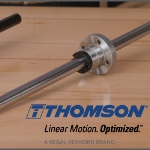 According to Thomson, "Precision ball splines have gained popularity as an ideal choice for applications that require low-friction linear and rotary motion. These components, which utilize a single splined shaft, enable complex movements in multiple directions." But how do you keep these ball splines performing at their peak for longer? Coatings can do the trick, and Thomson has three of them: black oxide, hard chrome plating, and nickel plating. Learn more about these coatings and which one makes the most sense for your precision ball spline solution.
According to Thomson, "Precision ball splines have gained popularity as an ideal choice for applications that require low-friction linear and rotary motion. These components, which utilize a single splined shaft, enable complex movements in multiple directions." But how do you keep these ball splines performing at their peak for longer? Coatings can do the trick, and Thomson has three of them: black oxide, hard chrome plating, and nickel plating. Learn more about these coatings and which one makes the most sense for your precision ball spline solution.
View the video.
Key factors for ball screw applications
 Learn the six key factors that should be considered when specifying ball screw assemblies in motion control applications. PCB Linear gathered a panel of experts in the field of linear motion to concentrate on this important topic -- particularly when it comes to the company's new miniature ball screw product line. Learn about precision and accuracy, orientation, speed and acceleration, duty cycle, linear motion travel, and load capacity. Podcast available too.
Learn the six key factors that should be considered when specifying ball screw assemblies in motion control applications. PCB Linear gathered a panel of experts in the field of linear motion to concentrate on this important topic -- particularly when it comes to the company's new miniature ball screw product line. Learn about precision and accuracy, orientation, speed and acceleration, duty cycle, linear motion travel, and load capacity. Podcast available too.
Read the PCB Linear blog.
3D printer uses pellet extrusion system instead of filament
 The latest addition to 3D Systems' industry-leading portfolio of EXT Titan Pellet systems is the EXT 800 Titan Pellet. With a build volume of 800 x 600 x 800 mm, this thermoplastics 3D printer harnesses the speed, reliability, and efficiency of the company's large-format pellet systems in a more compact unit with lower upfront investment. Use this machine to fabricate more modestly sized functional prototypes, tooling, fixtures, sand casting patterns, thermoforming molds, and end-use parts. Markedly faster than competing FFF and FDM printers, and up to 10X reduced material costs compared to filaments.
The latest addition to 3D Systems' industry-leading portfolio of EXT Titan Pellet systems is the EXT 800 Titan Pellet. With a build volume of 800 x 600 x 800 mm, this thermoplastics 3D printer harnesses the speed, reliability, and efficiency of the company's large-format pellet systems in a more compact unit with lower upfront investment. Use this machine to fabricate more modestly sized functional prototypes, tooling, fixtures, sand casting patterns, thermoforming molds, and end-use parts. Markedly faster than competing FFF and FDM printers, and up to 10X reduced material costs compared to filaments.
Learn more.
Test your knowledge: High-temp adhesives
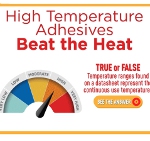 Put your knowledge to the test by trying to answer these key questions on how to choose the right high-temperature-resistant adhesive. The technical experts from Master Bond cover critical information necessary for the selection process, including questions on glass transition temperature and service temperature range. Some of the answers may surprise even the savviest of engineers.
Put your knowledge to the test by trying to answer these key questions on how to choose the right high-temperature-resistant adhesive. The technical experts from Master Bond cover critical information necessary for the selection process, including questions on glass transition temperature and service temperature range. Some of the answers may surprise even the savviest of engineers.
Take the quiz.
World's first current-carrying fastening technology
 PEM® eConnect™ current-carrying pins from Penn-Engineering provide superior electrical connections in applications that demand high performance from internal components, such as automotive electronics. This first-to-market tech provides repeatable, consistent electrical joints and superior installation unmatched by traditional fastening methods. Features include quick and secure automated installation, no hot spots or poor conductivity, and captivation options that include self-clinching and broaching styles.
PEM® eConnect™ current-carrying pins from Penn-Engineering provide superior electrical connections in applications that demand high performance from internal components, such as automotive electronics. This first-to-market tech provides repeatable, consistent electrical joints and superior installation unmatched by traditional fastening methods. Features include quick and secure automated installation, no hot spots or poor conductivity, and captivation options that include self-clinching and broaching styles.
Learn more about eConnect pins.
New flat quarter-turn clamping fastener
 IMAO Fixtureworks has expanded its One-Touch Fastener lineup to include a new quarter-turn clamping fastener that features an innovative flat design and is ideal for clamping in limited spaces. The QCFC flat quarter-turn fastener features a recessed body that protrudes only 2 mm from the mounted surface, a knob that rests flush inside the body, visible ON and OFF markings for safety, and an audible click when fully turned to clamped or unclamped position.
IMAO Fixtureworks has expanded its One-Touch Fastener lineup to include a new quarter-turn clamping fastener that features an innovative flat design and is ideal for clamping in limited spaces. The QCFC flat quarter-turn fastener features a recessed body that protrudes only 2 mm from the mounted surface, a knob that rests flush inside the body, visible ON and OFF markings for safety, and an audible click when fully turned to clamped or unclamped position.
Learn more.
Bellows and disc couplings with higher torque capacity
 Ruland Manufacturing now offers bellows and double disc couplings with bore sizes up to 1-3/4 in. or 45 mm for use in systems with torque up to 1,400 in.-lb (158 Nm). High-torque applications in precision semiconductor, solar, conveyor, and factory automation applications often use these shaft sizes. Ruland disc and bellows couplings accommodate all forms of misalignment, are zero-backlash, and have a balanced design for reduced vibration at speeds up to 10,000 rpm.
Ruland Manufacturing now offers bellows and double disc couplings with bore sizes up to 1-3/4 in. or 45 mm for use in systems with torque up to 1,400 in.-lb (158 Nm). High-torque applications in precision semiconductor, solar, conveyor, and factory automation applications often use these shaft sizes. Ruland disc and bellows couplings accommodate all forms of misalignment, are zero-backlash, and have a balanced design for reduced vibration at speeds up to 10,000 rpm.
Learn more.
Simplify your designs with slewing ring bearings
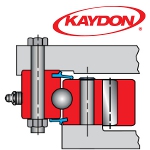 According to Kaydon Bearings, "A slewing ring bearing has rolling elements designed to create a reactive moment within the bearing's dimensions envelope to oppose applied (overturning) moment load," so you can use one bearing instead of two, reducing the height requirements, and even improve performance. Slewing ring bearings can also simplify a drive system by utilizing gear teeth on the inner or outer race. Learn all about slewing ring bearings in this informative article.
According to Kaydon Bearings, "A slewing ring bearing has rolling elements designed to create a reactive moment within the bearing's dimensions envelope to oppose applied (overturning) moment load," so you can use one bearing instead of two, reducing the height requirements, and even improve performance. Slewing ring bearings can also simplify a drive system by utilizing gear teeth on the inner or outer race. Learn all about slewing ring bearings in this informative article.
Read the Kaydon whitepaper.
Jet valve for ultra-small dispensing
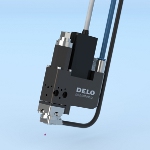 DELO's DELO-DOT PN5 LV pneumatic jet valve is designed for micro-dispensing low-viscosity adhesives and other media in miniaturized applications. Thanks to its compact design, it also requires very little space to install in production systems. Interchangeable nozzles with different diameters and a flexible, adjustable plunger stroke ensure precise and reliable applications at different droplet sizes. Volumes of as low as 1 nl can be achieved, which corresponds to droplet diameters of 250 µm or less.
DELO's DELO-DOT PN5 LV pneumatic jet valve is designed for micro-dispensing low-viscosity adhesives and other media in miniaturized applications. Thanks to its compact design, it also requires very little space to install in production systems. Interchangeable nozzles with different diameters and a flexible, adjustable plunger stroke ensure precise and reliable applications at different droplet sizes. Volumes of as low as 1 nl can be achieved, which corresponds to droplet diameters of 250 µm or less.
Learn more.
Stainless steel constant-torque flush-mount hinge
 Southco has introduced a flush-mount version of its popular and durable E6 constant-torque hinge. Its low-profile, corrosion-resistant package makes it an ideal solution for maximizing security, longevity, and aesthetics. It offers high torque for demanding applications while maintaining its low profile. Lots of uses.
Southco has introduced a flush-mount version of its popular and durable E6 constant-torque hinge. Its low-profile, corrosion-resistant package makes it an ideal solution for maximizing security, longevity, and aesthetics. It offers high torque for demanding applications while maintaining its low profile. Lots of uses.
Learn more.
Claw vacuum pump for industrial applications
 Vacuum expert Leybold has added a new model to its proven CLAWVAC dry claw vacuum pump series: the CLAWVAC CP B. This innovative, rough vacuum pump, designed for robust processes including food processing, material handling, and environmental industries, is powerful, energy efficient, and easy to clean. The intuitive handling of this unit is mainly due to its functional design, which features a pair of claws that rotate in the cylinder with no contact or wear. Its separate gearbox prevents oil contamination. The design ensures short downtimes and long service intervals: 20,000 hr between oil changes and up to 48,000 hr between general overhauls.
Vacuum expert Leybold has added a new model to its proven CLAWVAC dry claw vacuum pump series: the CLAWVAC CP B. This innovative, rough vacuum pump, designed for robust processes including food processing, material handling, and environmental industries, is powerful, energy efficient, and easy to clean. The intuitive handling of this unit is mainly due to its functional design, which features a pair of claws that rotate in the cylinder with no contact or wear. Its separate gearbox prevents oil contamination. The design ensures short downtimes and long service intervals: 20,000 hr between oil changes and up to 48,000 hr between general overhauls.
Learn more.
DualVee linear guides and tracks used in warehousing
 See how Bishop-Wisecarver's DualVee® motion tech can add huge benefits to warehousing operations. This video highlights two applications: a manual storage and retrieval system and an automated storage and retrieval system of long aerospace-grade carbon fiber in sub-zero temps. Patented DualVee guides and tracks keep operations running smoothly.
See how Bishop-Wisecarver's DualVee® motion tech can add huge benefits to warehousing operations. This video highlights two applications: a manual storage and retrieval system and an automated storage and retrieval system of long aerospace-grade carbon fiber in sub-zero temps. Patented DualVee guides and tracks keep operations running smoothly.
View the video.
Build-to-order knobs and hand hardware
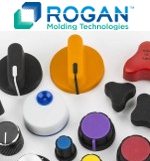 Rogan Corp.'s innovative use of two-shot plastic injection and insert molding has been providing customers with high-quality plastic clamping knobs, levers, and control knobs for almost 90 years. Rogan offers concurrent engineering, product design, and assistance in material selection to ensure customer satisfaction for standard or customized parts, with a focus on cost optimization and on-time delivery. Custom colors, markings, decorative inlays, or engineered materials to meet special requirements, such as adding extra strength or utilizing flame-retardant material, are all offered.
Rogan Corp.'s innovative use of two-shot plastic injection and insert molding has been providing customers with high-quality plastic clamping knobs, levers, and control knobs for almost 90 years. Rogan offers concurrent engineering, product design, and assistance in material selection to ensure customer satisfaction for standard or customized parts, with a focus on cost optimization and on-time delivery. Custom colors, markings, decorative inlays, or engineered materials to meet special requirements, such as adding extra strength or utilizing flame-retardant material, are all offered.
Learn more.
Slewing ring bearing made of wood and plastic
 The PRT-02-30-WPC slewing ring bearing is another step forward by igus toward integrating renewable raw materials into industrial production. Made of 50% wood and 50% high-performance plastics, the cost-effective and lubrication-free slewing ring bearing balances strength and durability with a proven low CO2 footprint. The materials incorporate solid lubricants, making the new slewing ring bearing smooth running and maintenance-free.
The PRT-02-30-WPC slewing ring bearing is another step forward by igus toward integrating renewable raw materials into industrial production. Made of 50% wood and 50% high-performance plastics, the cost-effective and lubrication-free slewing ring bearing balances strength and durability with a proven low CO2 footprint. The materials incorporate solid lubricants, making the new slewing ring bearing smooth running and maintenance-free.
Learn more.
Flex Locators for quick fixture changeover
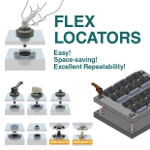 Flex Locators from Fixtureworks are designed for quick changeover of small and large fixtures, automation components, and more. They are ideal for applications that require frequent disassembly, providing excellent repeatability for locating and clamping in a single operation. Manual and pneumatic versions are available. Just turn the handle, knob, or screw!
Flex Locators from Fixtureworks are designed for quick changeover of small and large fixtures, automation components, and more. They are ideal for applications that require frequent disassembly, providing excellent repeatability for locating and clamping in a single operation. Manual and pneumatic versions are available. Just turn the handle, knob, or screw!
View the video.
Army develops cold spray technology to repair Bradley gun mounts
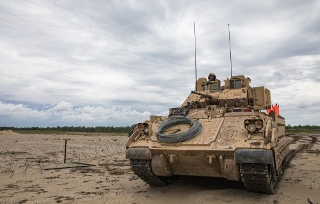
An Army M2 Bradley Fighting Vehicle stages out on a breaching range during a dry run of dismounted breach training conducted on a range in Poland, May 23, 2019. With funding from the Army's Manufacturing Technology Program, a team of scientists and engineers from the U.S. Army CCDC worked together to develop a cold spray process to repair costly turret gun mounts on the Army's M2 Bradley Fighting Vehicle. [Photo Credit: Jeremiah Woods]
By Argie Sarantinos-Perrin, CCDC, Aberdeen Proving Ground, MD
Repairing a 40-ton armored vehicle is a lot harder than having your car fixed at a neighborhood auto repair shop. Tactical armored vehicles require specialized repair procedures, which are very costly. What if repairing routine wear and tear on an Army vehicle was inexpensive and as easy as fixing your car?
With funding from the Army's Manufacturing Technology Program, a team of scientists and engineers from the U.S. Army Combat Capabilities Development Command (CCDC) Army Research Laboratory, Ground Vehicle Systems Center, and the Armaments Center, as well as Bradley Product Manager and Red River Army Depot (RRAD) worked together to develop a cold spray process to repair costly turret gun mounts on the Army's M2 Bradley Fighting Vehicle.
"This project demonstrated the ability to apply new manufacturing technologies to bring components back into service that would otherwise be scrapped during depot maintenance operations," said Gehn Ferguson, CCDC ARL materials engineer.
The project began in 2017 when CCDC ARL visited RRAD to view the inspection process and access the wear on the Bradley turret gun mounts. RRAD, the primary depot responsible for the Bradley vehicle, inspects gun mounts for excessive wear. In subsequent months, CCDC ARL developed and demonstrated a process for repairing the gun mounts using cold spray. Prior to developing the cold spray process, worn gun mounts that were inspected and identified as non-repairable were disposed of.
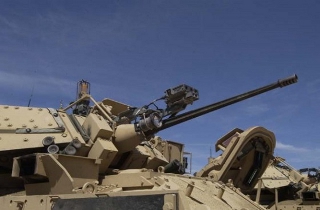
The 25-mm gun mount supports the gun barrel on the M2 Bradley Fighting Vehicle. When the mount begins to wear unevenly, the barrel becomes less stable. The Army is evaluating if a cold spray process can be used to repair the gun mount. [Photo Credit: U.S. Army]
"Cold spray is an emerging technology that will enable the Army to reclaim worn components that were previously replaced with new parts. This new technology reduces lifecycle cost and improves systems availability," Ferguson said.
While the cost of a new 25-mm gun mount is more than $25,000, a cold spray repair costs approximately $1,000. Additionally, the cold spray process improves readiness by reducing the time that a Bradley is out of service while lessening the burden on the supply chain by reducing the necessity for stockpiling new gun mounts.
Cold spray is a process where micron-sized particles are accelerated in a high-velocity gas stream through a nozzle and subsequently consolidated on a target surface. The accelerated particles impact and bond to the surface, resulting in a buildup of the sprayed material. Both the sprayed particles and the target surface remain solid during the process.
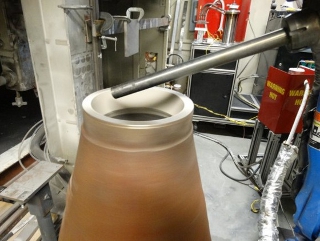
Using the cold spray process, CCDC Army Research Laboratory restored the internal diameter of the gun mount exit throat to its original drawing dimensions, demonstrating the ability to return worn gun mounts back into service. [Photo Credit: U.S. Army]
The Bradley turret gun mount was selected as a candidate for the cold spray repair process because CCDC ARL has extensive experience working with similar steels, and an established process to repair the worn gun mounts didn't exist. CCDC Armaments Center was responsible for designing and engineering the turret, and CCDC ARL developed and demonstrated the cold spray repair procedure. The Tank-Automotive and Armaments Command is reviewing the repair and overhaul instructions currently under development. The team plans to repair four or five gun mounts within the next six months.
While the project initially began as a way to repair gun mounts, the material used in the cold spray process is much more durable, which suggests it could even be used to extend the life of new gun mounts.
Cold spray is also being evaluated for use with other applications, including the ability to repair corrosion on combat vehicle surfaces and possibly to coat the interior of cannon barrels. For example, if the inside of a cannon barrel can be effectively coated with tantalum, which is a very durable material, its service life can be extended.
"As the command develops new weapon systems, there will be more opportunities to leverage the cold spray process to augment or repair components that may otherwise be labeled unusable. We're hoping this new manufacturing technology will lead to more success stories that will validate challenging requirements for improved readiness and reduce the lifecycle operation and sustainment costs of current and future tactical systems," Ferguson said.
Published September 2019
Rate this article
View our terms of use and privacy policy

